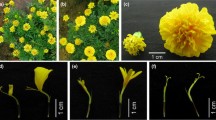Summary
-
1.
After treatment of dry seeds of red pepperCapsicum annuum L. with X-rays a male-sterile mutant was discovered in the M2.
-
2.
The male-sterile mutant segregates in a ratio of 3.28:1 (χ2=3.148, probability 0.07).
-
3.
After an alternative cultivation of male-sterile plants and of a variety with good combining ability relatively good fruit-setting and seed production was obtained.
-
4.
Grafting of male-sterile scions to normal stocks does not affect the male-sterile phenotype.
Zusammenfassung
-
1.
Nach der Behandlung von trockenen Paprika (C. annuum L.)-Samen mit Röntgenstrahlen wurde in der M2 eine männlich-sterile Mutante entdeckt.
-
2.
Die männlich-sterile Mutante spaltet im Verhältnis 3.28:1 (χ2=3,148, Wahrscheinlichkeit 0,07).
-
3.
Bei einer alternativen Auspflanzung von männlich-sterilen Pflanzen und einer Sorte mit guter Kombinationseignung wurde ein verhältnismäßig guter Fruchtansatz und eine ausreichende Menge Samen erzielt.
-
4.
Die Pfropfung männlich-steriler Reiser auf eine normale Unterlage beeinflußt den männlich-sterilen Phänotyp nicht.
Similar content being viewed by others
Literature
Angeli, L. Heterosis paprika termesztesi kiserletik. Kulonlenyomat a kerteszeti kutatointeret evkonykebol2 (1957).
Christoff, St. Results of trials about the application of heterosis by pepper and the establishment of technique for producing hybrid seeds for practical purpose (bulg.) Selskost. misal. suppl. series Rast.1 (1956).
Daskaloff, H., andT. Murtazov: New heterosis red pepper varieties for cultivation under glass or early out-door production (bulgar.) Izv. Inst. Rast. (Sofia)3, 3–17 (1955).
Daskaloff, H., andD. Popova: New early ripening hybrid varieties by pepper (bulgar.). Izv. Zentr. Inst. Rast. (Sofia)9, 185–195 (1960).
Deshpande, R. B.: Studies in Indian chillies. 3. The inheritance of some characters inCapsicum annuum L Indian J. Agr. Sci.3, 219–300 (1933).
Fujii, K., W. Masabayashi andT. Kuwahara: Studies on the utilization of F2 generations of red-pepper crosses. Agr. and Hort.34, 667–668 (1959).
Lippert, L. F., B. O. Berch andP. G. Smith: Gene list for the pepper. J. Heredity56, 30–34 (1965).
Martin, J. A.: Preliminary studies on the influence of F1 and F2 seed on the yield of Cayenne peppers. Proc. Assoc. South. Agr. Workers46, 111 (Abstr.) (1949).
Martin J. A., andI. H. Crawford: Several types of sterility inCapsicum frutescens. Proc. Am. Soc. Hort. Sci.57, 335–338 (1951).
Ohta, Y.: The introduction of cytoplasmatic male sterility inCapsicum breeding. Seiken Ziho12, 59–60 (1961).
Pal, B. P.: Studies in hybrid vigour. 1. Notes on the manifestation of hybrid vigour in grams, sesamum, Chilli and maize. Ind. J. Genet. and Plant Breed.5, 106–121 (1945).
Peterson, P. A.: Cytoplasmically inherited male sterility in Capsicum. Am. Nat.92, 111–119 (1958).
Rusinova-Kondareva, I.: Results of the investigation on pepper male sterile form (bulg.). The use of the male sterility in hybrid seed production, Sofia, 147–152 (1965).
Author information
Authors and Affiliations
Rights and permissions
About this article
Cite this article
Daskaloff, S. A male sterile pepper (C. annuum L.) mutant. Theoret. Appl. Genetics 38, 370–372 (1968). https://doi.org/10.1007/BF00934170
Issue Date:
DOI: https://doi.org/10.1007/BF00934170




